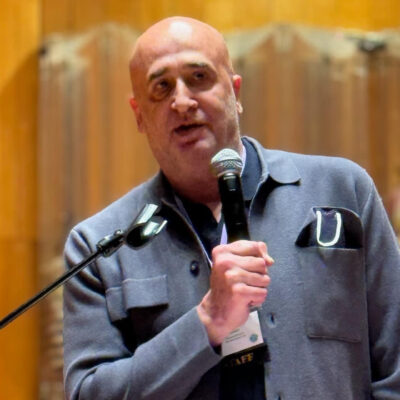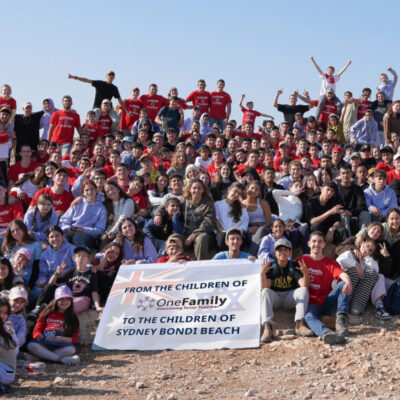Because We Are Jewish

[This essay is from The Peoplehood Papers, volume 19 – “For You Were Strangers in the Land of Egypt” – published by the Center for Jewish Peoplehood Education.]
By Mark Hetfield
HIAS was founded in 1881 to welcome refugees because they were Jewish. Today, HIAS welcomes refugees because we are Jewish.
While the term “genocide” was not coined until 1944, HIAS was established at the end of the 19th Century in response to the genocide occurring in Eastern Europe – the pogroms targeting Jews which sparked the largest mass migration of Jews since the 15th Century, when Ferdinand and Isabella expelled all Jews and Muslims from the Iberian Peninsula.
HIAS was founded as the Hebrew Immigrant Aid Society by the members of the New York Jewish community. In HIAS’ first 40 years (1881-1921), the same amount of time for which Moses wandered in the desert, the American Jewish population grew from 250,000 to over 3 million. Most of these new Jewish-Americans were refugees from Eastern Europe who were assisted by HIAS in Castle Garden (known as kesselgarten to HIAS’ Yiddish speaking clients) and Ellis Island. HIAS fed them kosher meals, provided them legal counsel to ensure that the immigration authorities would not turn them away, sheltered them after they were allowed in, and paid for onward transportation to other cities. The bottom line is that the American Jewish community today owes its very existence to those times when America opened its doors to refugees.
America was very welcoming to Jewish refugees, until it wasn’t. With the Emergency Quota Act of 1921, Congress shut America’s doors to most Jewish refugees and immigrants by requiring visas prior to arrival and setting nationality quotas that were openly discriminatory against Eastern and Southern Europeans, forcing HIAS to become an international agency in order to find other countries that would take Jewish refugees. The legislation was originally set to expire after only one year, but instead was made even stricter by the U.S. Congress. These immigration restrictions continued to be in effect after the passage of the Nuremberg laws, Kristallnacht, the Second World War and the Holocaust, when millions of Jews were trapped inside a genocide. Canada, South Africa and Australia all followed the example of the United States and shut their doors as well, so HIAS had to find resettlement places and temporary asylum for Jewish refugees in Latin America and Asia.
In 1948, two major events happened which made the work of HIAS easier: First, the establishment of the state of Israel, so Jewish refugees finally had a place to go; and second, the Universal declaration of Human Rights which, in Article XIV, recognized the right to seek and enjoy asylum. With this, people finally have the right to flee, and should never again be trapped inside of a genocide. This right was implemented by the 1951 Convention on Refugees.
From 1948 to 2005, HIAS was largely focused on the resettlement – to the United States, Israel, and elsewhere – of Jewish refugees from the Middle East, the displaced persons camps in Europe, from behind the Iron Curtain, and Cuba.
Around 1970, HIAS resumed its assistance to Russian speaking refugees from the former Soviet Union, assisting over 400,000 Soviet Jews to find safety and freedom from the USSR from 1970 through the beginning of the 21st Century.
Today, with few Jews left “in captivity,” HIAS has turned Jewish values and history into action – moving from our “Exodus period” to our “Leviticus period” – helping refugees not because they are Jewish, but because we are Jewish. Working in close partnership with the United Nations Refugee Agency (UNHCR), HIAS works with refugees and asylum seekers in the United States, Latin America, Israel, Africa, and Eurasia to provide them with legal protection, psycho-social assistance, and livelihoods. When HIAS cannot safely integrate refugees where they are, and when it is unlikely they will be able to safely return home, HIAS works to resettle them to third countries like the United States, Canada, and Australia.
In communities across the United States, HIAS welcomes refugees in partnership with the United States government and local partners, including both Jewish family service agencies as well as independent organizations. We welcome refugees of many faiths and ethnicities upon arrival at airports, bring them to furnished and food-stocked apartments which we found for them, enroll their kids in school, teach them English, help them find jobs, all so they can become employed and self-sufficient as soon as possible. Above all, we do our best to help them become new Americans, just like we did for Jewish refugees for well over a century.
Today, with the rise of nationalism, xenophobia and Islamophobia across the world and in the United States, the work of HIAS has become particularly challenging. But we have faced those challenges before, fought them, survived them, and overcome them. HIAS will always be there to find asylum for Jews fleeing persecution. But we have learned the lessons from the Torah – where the commandment to love the stranger as ourselves, for we were once strangers in the land of Egypt, is repeated no less than 36 times – and from our own history. HIAS is now there for anyone who is a refugee. In 2016, of the 4186 refugees welcomed by HIAS to the United States, 51% were Muslim. 4% were Jewish.
In 2017, HIAS drafted a statement, signed by over 2000 rabbis from 48 of the 50 states and the District of Columbia, representing all major movements of Judaism, asserting that America must remain a welcoming country for refugees. Over 350 Jewish congregations in the United States have signed on to the HIAS “welcome campaign.” HIAS is not just a Jewish organization for refugees, it is truly the refugee organization of the American Jewish community. That is our greatest strength.
Mark Hetfield is an attorney who serves as President and CEO of HIAS, which he originally joined in 1989 as a caseworker in Rome. He has also held positions with the US Immigration and Naturalization Service, the US Commission on International Religious Freedom, and the law rm of Fulbright and Jaworski.

 Add EJP on Google
Add EJP on Google










